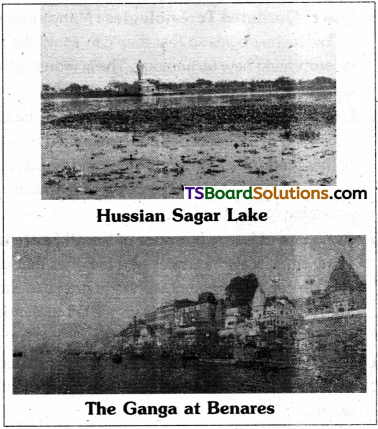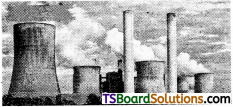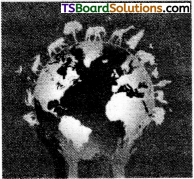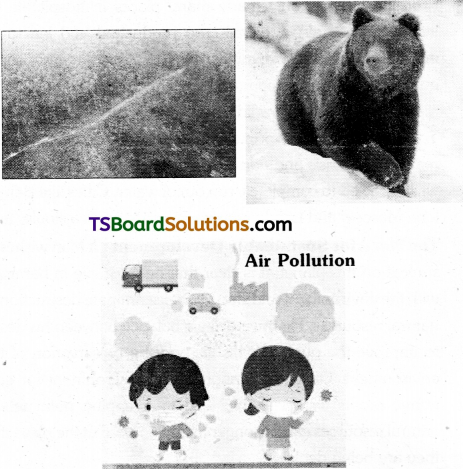Telangana TSBIE TS Inter 1st Year Environmental Education Study Material 5th Lesson Effects of Industrial Development Textbook Questions and Answers.
TS Inter 1st Year Environmental Education Study Material 5th Lesson Effects of Industrial Development
Esssay Questions
Question 1.
Write an essay on pollution in terms of Industrial Development. List out the reasons why pollution control measures are difficult to implement.
Answer:
The Dark side of Industrial Development :
The Industrial Revolution in the eighteenth century marked the beginning of the mass production of goods. As technology developed, factories multiplied exponentially. Prior to industrialization, there were only small factories or cottage industries, often run by small families. Factories were few in number and working hours were limited. By and the environment was clean.
In order to provide for the daily needs of the growing population, different types of industries have now been established. These industries use raw materials, process them and produce finished products. Besides the finished products, a good number of by products are produced. If the processing of waste is a cost prohibitive one, then the industrialist is often tempted to throw the waste matter into the environment instead of disposing it in a responsible manner. The waste may be in the form of gas, liquid or solid. The gases are usually released into the atmosphere, the liquids are discharged into aquatic bodies like canals, rivers or seas and solid wastes are either dumped on the land or in aquatic bodies.
In all the cases, the air, water or land is fouled due to the dumping of wastes. The fouling of the environment because of industrialization is referred to as ‘industrial pollution’. It is the undesirable outcome when factories or other industrial plants emit harmful by-products and waste into the environment. Emission of toxic chemicals into the atmosphere causes air pollution. Effluents released into water bodies cause water pollution. When soil is degraded by harmful substances, it is called soil pollution.
The Central Pollution Control Board, India has identified 17 industries which cause the most pollution. They include industries pertaining to fertilizers, pesticides, and pharmaceuticals, apart from petroleum refineries and steel plants.
Air Pollution :
Due to industrial activities, a variety of poisonous gases and substances like carbon dioxide, sulphur dioxide and dusts are spewed into the atmosphere, causing acute pollution. The quality of the air is vitiated also by the large number of autgmobiles which emit toxic fumes and particulate matter. The .burning of crop stubble, common in states like Punjab and Haryana, is another major cause of air pollution, especially in winter. Delhi is covered with thick smog and a “toxic cloud” at such times. The presence of pollutants in the air disturbs the natural eco-system. It affects the well-being and health of all living organisms, including human beings, animals and plants.
Water Pollution :
Effluents released by industries into water bodies contain harmful pollutants like lead, mercury and petro-chemicals. These pollutants contaminate the water of lakes, ponds, rivers and seas. Aquatic plants and animals are adversely affected. The improper disposal of sewerage and the seepage of industrial effluents into the soil results in the contamination of groundwater. The water becomes unfit for human consumption as it contains harmful compounds and also disease causing pathogens.
Hussain Sagar Lake, once the pride of Hyderabad is now choked with agricultural waste, pharma residues, municipal sewage, and industrial effluents. The Ganga has now become the 6th most polluted river in the world. Numerous tanneries, textile mills, and chemical plants discharge untreated waste into it everyday. Besides, about 3 billion litres of untreated sewage are dumped into the river daily. The National Mission to Clean Ganga aims to clean the Ganga and its tributaries in a comprehensive manner.

Soil / Land Pollution :
Soil Pollution is defined as the presence of toxic chemicals in soil, in high enough concentrations to pose a risk to human health and/ or the ecosystem. Pesticides and chemical fertilizers used by farmers contain harmful compounds that contaminate the soil and are harmful when ingested by human beings or animals. Effluents and sludge discharged by industries pollute not only water bodies but land too.
Why Pollution Control Measures are Difficult to Implement :
In developing and under developed countries Pollution Control measures are difficult to implement because of the following reasons :
Lack of Policies to Control Pollution :
Lack of effective policies and poor enforcement of laws framed by the Pollution Control Board has resulted in unchecked pollution.
Use of Outdated Technologies :
Many industries still rely on old technologies so that they can avoid the high cost of incorporating new technology. These industries continue to generate large amounts of toxic waste.
Unplanned Industrial Growth :
Many industries have expanded in a haphazard and unplanned manner Owners of these industries may flout rules and norms pertaining to pollution control as it may not be economically feasible or profitable to do so.
Presence of Large Number of Small Scale Industries :
Many small-scale industries and factories that do not have enough capital rely on government grants to run their day-to-day businesses. They may not fall under the ambit of stringent environment regulations.
Inefficient Waste Disposal :
Water pollution and soil pollution are often the consequence of inefficient disposal of waste.
![]()
Question 2.
List out the impact of Industrial Development and other human activities on the environment and the need for sustainable development.
Answer:
Since 1950 urban populations have increased seven-fold, energy use has soared five times, while the amount of fertiliser used is now eight times higher. Human activities are responsible for causing environmental degradation. The deterioration of the environment is manifested in many ways such as the depletion of resources like air, water and soil: the destruction of ecosystems; habitat destruction; the extinction of wildlife; and pollution.

The table below highlights the impact of development on the environment.
Adverse Impact of Development on The Environment
| Developments/Human Activities in the Modem Age | Impact on the Environment |
Urbanization and Population Explosion |
• Deforestation/ Loss of billions of forest trees. • Forest areas are converted to farm lands/ residential townships. • Depletion of available natural resources. • Decrease in rainfall. • Increase in global temperature/ global warming affecting humans and also animals like the polar bear. • Changes in climatic conditions. • Increase in natural calamities like floods, earthquakes and droughts. • Loss of wild life – tigers, elephants, snakes etc. • Extinction of several plant species. |
| Developments/Human Activities in the Modem Age | Impact on the Environment |
Industrialization and Mining |
• Loss of raw materials like wood, ores and minerals. • Discharge of effluents/by products into the air. water and soil, thereby causing severe pollution. Water pollution – causes diseases like cholera and cancer, affects marine life. Air pollution – causes respiratory diseases, including cancer, vitiates the quality of air. • Fertility of soil is affected. • Loss of massive tracts of land, affecting crop production. |
Commercial fishing |
• Disturbance to the ecosystem, ecological imbalance, disruption of the food chain. • Threat of extinction of aquatic animals such as tunas and sharks. • Destruction of coral reefs. |
Commercial Agriculture and Livestock Farming |
• Deforestation due to plantation crops, burn and slash agriculture, grazing of livestock. • Chemical pesticides and fertilizers used in commercial agriculture are toxic. • Livestock (farm animals like cows and sheep) accounts for 40% of global emissions of gases like methane which contribute to global warming. |
Tourism |
• Loss of forest land. • Pollution of the natural resources due to construction of hotels, tourist influx, usage of plastic. • Disturbance to the ecosystem. • Threat to wild life. |
| Developments/Human Activities in the Modem Age | Impact on the Environment |
Production & disposal of waste |
• Waste material, such as sewage, either in solid or liquid or gaseous form, is toxic and poses a health hazard. • Improper disposal and dumping of garbage in cities leads to unhygienic conditions and spread of diseases. In Hyderabad alone, about 4500 tons of garbage is collected every day, of which only 30% is recycled. |
Killing of Wild Life for trade |
• Unchecked poaching has led to several species of animals becoming extinct. For eg. elephants are killed for their ivory tusks, rhinos for their horns, antelopes for fur, sharks and gorillas for meat, tigers for their skin and for other organs which are believed to have medicinal properties. |
Transportation |
• Particulate matter (PM) emitted by vehicles causes smog, respiratory diseases, cancer. • Noise pollution caused by vehicles and jets affects the nervous system; hearing is impaired. |
The Cost of Development :
Developed countries are generally highly industrialized and are technologically far more advanced than developing or under developed countries. The per capita income of the citizens in developed countries is very high and the people living there enjoy high standards of living. Thus, a country is deemed to be ‘advanced’ if it is dotted with skyscrapers, industries and express highways, and its citizens drive fancy SUVs and use all the latest technological gadgets.
But at what cost does such development take place? In his quest for Development, man is ruthlessly destroying the environment. It is estimated that for paper alone, about 4 billion trees are cut worldwide every year. Every”day, more than 2 million tons of sewage and industrial and agricultural waste are discharged into the world’s water, the equivalent of the weight of the entire human population. Deforestation, industrialization and population explosion have wreaked havoc on Nature. Glaciers are melting and groundwater aquifers are running dry. Weather patterns are changing worldwide and thousands of species of animals and plants are becoming extinct.
Man cannot escape the consequences of his actions. Global warming has not only made many places inhospitable for a living but has also affected crop production and led to an increase in natural calamities. Hoods, droughts, and earthquakes have become common throughout the world. Natural resources like water are rapidly becoming scarce. Recently Cape Town, the 2nd most populous city in South Africa, faced a major water crisis and narrowly escaped Day Zero, the day it was expected to completely run out of water. Cities like Bangalore, Moscow, and London are predicted to meet a similar fate.
The Need for Sustainable Development:
If Man wishes to survive on this planet, it is clear that he must live in harmony with the environment and stop the indiscriminate destruction of natural resources. He must strike a balance between his desire to improve the quality of his life and the preservation of the environment. Over-exploitation of the environment for economic profits will inevitably lead to a tipping point where natural resources can no longer be replenished at the place where they are being depleted.
The United Nations Conference on Environment and Development (UNCED) defines the concept of Sustainable Development. Sustainable Development is a development that meets the needs of the present generation without compromising the ability of future generations to fulfill their own needs. Sustainable development rests on three pillars – Environment, Economy, and Social Equity. If one of the pillars is weak, the system will collapse. Economic Sustainability ensures that the greed to make profits is curbed and that the environment is not damaged. Social Equity envisages the just and equitable sharing of resources among the rich and the poor, whether on an individual or global level. These pillars are also referred to as the 3 Ps- People, Profit, and Planet.
